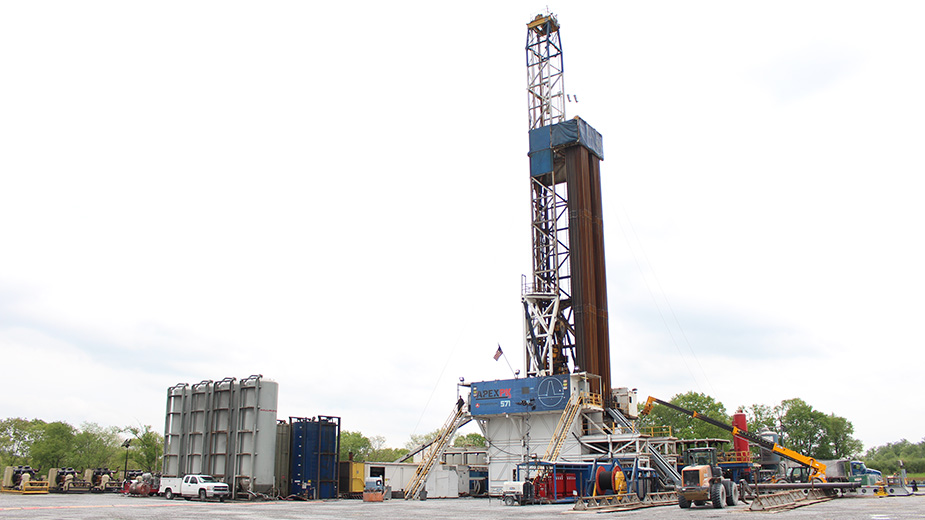Injection Well Use Down in Trumbull, Up in Mahoning
YOUNGSTOWN, Ohio — Four years ago, Trumbull County was widely considered the dumping ground for contaminated wastewater that resulted from drilling oil and gas production wells across the Utica and Marcellus shale plays in Ohio and Pennsylvania.
In 2014, companies that operated Class II injection wells in the county reported they collectively accepted more than 2.9 million barrels of contaminated waste, the second-highest level in Ohio at that time.
A sluggish oil and gas market led energy companies to pull back their drilling programs, reducing business for many of these operations. Other factors, including stream water and wildlife contamination, led to many of the injection wells closing down completely, leaving drilling sites shut in and abandoned.
Last year, Trumbull County recorded just seven active wells of the 17 once in service, according to the Ohio Department of Natural Resources. Together, those wells took in just 784,354 barrels of drilling wastewater, slightly above 2016’s total of 651,537.
“We’ve got all of ours shut down now,” says Bob Barnett, president of American Energy Associates Inc., based in Cortland. “We really don’t have enough business.”
American Energy operated an injection well in Greene Township and drilled another in Brookfield Township that was never activated, Barnett says. Initially, business was good for the well in Greene Township, but activity plunged once new drilling ground to a halt.
Meanwhile, those energy companies that continued to drill through the downturn started to ship their wastewater farther south, away from Trumbull County.
“We were going crazy at first,” Barnett recalls. However, energy companies such as Halcon Resources Corp. and BP America, which amassed a strong acreage position in Trumbull County during the early Utica land rush, failed to establish a lasting presence and abandoned the region.
Other drillers in western Pennsylvania’s section of the Utica, such as Hilcorp Energy Co., moved much of their wastewater to new injection wells in Mahoning County.
“Right now, we’re trying to sell the well in Brookfield,” Barnett says. “There’s been some interest.”
Brookfield recently emerged as the focus for any new injection well activity in the Mahoning Valley. Last year, Highland Field Services, a division of Pittsburgh-based Seneca Resources, received permits from ODNR to develop two Class II wastewater injection wells just west of state Route 7. The company has requested permits for three additional wells at the site.
“All we’re doing is clearing the property,” says Rob Boulware, spokesman for Seneca Resources. “I don’t have a timeline on the project.”
Boulware says that the new wells aren’t intended as a stand-alone moneymaking operation but rather as a necessity that comes with oil and gas exploration.
Seneca Resources has drilling programs in the Marcellus shale in Pennsylvania and the Brookfield wells would handle mostly the waste generated from those operations. Highland Field Services also operates a fully contained water recycling operation in McKean County, Pa.
In 2017, Highland recycled 100% of the fluids Seneca produced – or 5.2 million barrels. This recycled water accounted for 75% of Seneca’s total fluid consumption for its completed wells last year.
Boulware says that the system helped to save some 700,000 trips trucks would have had to take hauling water to and from drilling sites.
The prospect of new injection wells in Trumbull County and growing wastewater disposal across the state pose more environmental risks, says Teresa Mills, executive director for the Ohio Environmental Network. “In Trumbull County, most of the wells are down and now five more are being proposed for Brookfield,” she says. “I just don’t understand it.”
Mills tracks disposal volumes in every active injection well in Ohio. Ironically, while the number of wells has fallen over the years, the volume of wastewater pumped into the ground has increased, a trend that concerns her.
“Last year, we injected more waste in Ohio than at any time over the last six years,” she says. In 2012, the state reported that Ohio’s disposal wells accepted 14.1 million barrels of wastewater for underground storage. In 2017, that number stood at 32.4 million barrels. About half of that waste is generated outaide the state, mainly from Pennsylvania.
Injection wells pose a risk to the environment and the public, Mills says, and she doesn’t buy that the state is tougher on enforcing the regulations that govern how they are operate. She points to a well that is shut down in Coshocton because of a hole in one of its casings.
“They’ve applied to change it to a Class I disposal well, which is dangerous, because you can inject any type of waste in it,” she says.
Moreover, Mills says the state has yet to promulgate final rules on disposal wells, which it promised to do in 2014. “They say there are more regulations today,” she scoffs. “It’s a fallacy. It’s laughable.”
And while less waste is being dumped in Trumbull County, Mills notes that more wastewater is being trucked into Mahoning County. “Mahoning County ranks ninth in the state” in terms of drilling wastewater volumes.
In 2017, ODNR records show, injection wells in Mahoning County accepted more than 1.2 million barrels. In 2012, wells in Mahoning County accepted just 138,737 barrels.
The shift is mostly because of a well that began operations two years ago, Bobcat Energy’s North Lima Disposal well just off state Route 7. The vast majority of wastewater – 1.183 million barrels – disposed of in Mahoning County was sent to this well in 2017, according to ODNR. And most of this waste, or about one million gallons, was generated from out-of-state drilling operations, records show.
Most wastewater trucked into Trumbull County ing 2017 also found storage in a single well, according to ODNR records. The well, operated by KTCA Holdings LLC of Oklahoma City, opened last year along state Route 193 near the Youngstown-Warren Regional Airport in Vienna. It accepted 522,321 barrels of the 784,354 barrels of wastewater disposed in Trumbull during 2017.
That well was formerly operated by KDA, a subsidiary of Kleese Development. In 2016, KDA’s operations shut down after one of its wells was found to have contaminated a stream and pond in Vienna. The company’s five wells remain inactive today.
Other inactive wells include American Water Management Services LLC’s two injection operations in Weathersfield Township. The company, a subsidiary of Avalon Holdings Corp., is engaged in a lengthy legal battle with the state to re-activate those wells after they were shut down in the wake of seismic activity near the site.
“What the state did was take our property, and we’ve lost a lot of money,” says Ron Klingle, chairman of Avalon Holdings. He says the seismicity detected near the wells registered between 1.9 and 2.1 on the Richter scale and thus could not have been felt by anyone on the surface.
To underscore his point, Klingle says since his wells were shut down, there have been more than 3,000 small tremors in the region that registered within those levels but, to his knowledge, the state never investigated those events. “I don’t know why they did what they did,” he says.
ODNR’s oil and gas division ordered American Water Management’s wells shut down in 2014, three years after an injection well in Youngstown was found to have caused a 4.0 magnitude earthquake Dec. 31, 2011.
American Water Management pursued legal action against the state so it can restart those wells. Last fall, Franklin County Common Pleas Court ruled for the company and ordered the wells reopened. The state has appealed and the case is before the 10th District Court of Appeals.
“We didn’t violate a single law or any conditions,” Klingle says. “Now, we’re waiting.”
Pictured at top: KTCA Holdings of Oklahoma City operates the Copper Ridge Disposal injection well in Vienna. Last year this well disposed of two thirds of the drilling waste sent to Trumbull County.
Copyright 2024 The Business Journal, Youngstown, Ohio.



